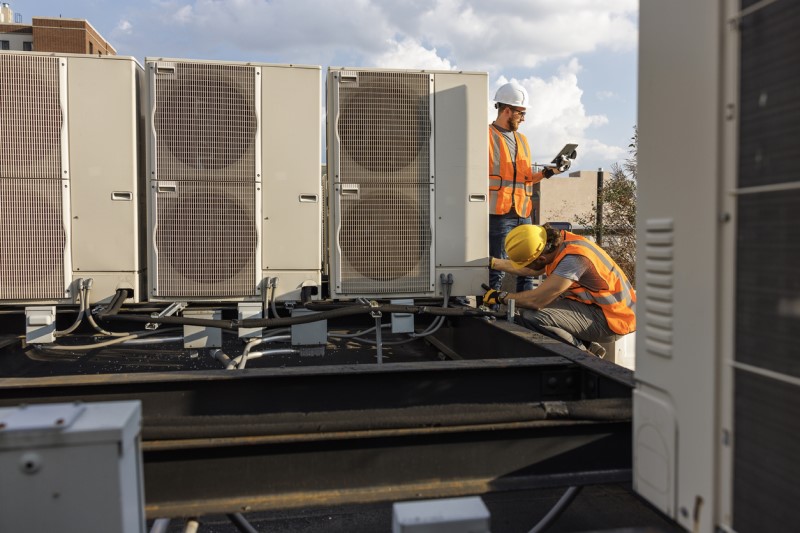Key Steps In Commercial HVAC Installation
Commercial HVAC systems are vital to creating a comfortable and efficient environment for your business or tenants. Are you looking to install a new commercial HVAC system? Are you designing a building and wondering which commercial HVAC system is the right fit? Modern commercial HVAC systems can be complex and require specialized knowledge to select and install. As you prepare to invest in a new system, let’s review the key steps in commercial HVAC installation.
Designing and Planning the HVAC System
A well-designed commercial HVAC installation starts with determining the load capacity for the building. The size and orientation of the building are important factors when designing a commercial HVAC system and calculating the size needed. Other factors include ease of maintenance, seasonal temperature factors, building materials used, expected business activities, and compliance with local building codes. These and other factors influence the type of commercial HVAC system selected for the building.
Types of Commercial HVAC Systems
- Packaged HVAC Systems – Small to Medium-Sized Commercial Spaces
Packaged HVAC systems are self-contained units that house all the major components in a single cabinet. These systems are often installed on rooftops, saving indoor space and simplifying installation and maintenance. - Split HVAC Systems – Large Commercial Spaces
Split HVAC systems consist of an outdoor unit containing the condenser and a compressor. The outdoor unit connects to an indoor unit containing the evaporator coil and air handler. Split HVAC systems provide installation flexibility and control the temperature in different areas. - Variable Refrigerant Flow (VRF) Systems – Energy Efficient
VRF systems can adjust refrigerant flow to meet specific demands, optimizing energy consumption and enabling precise temperature control in each zone. - Heat Pump Systems – Energy Efficient
Heat pump systems are versatile and can provide both heating and cooling. They work by transferring heat from one area to another using refrigerant technology. - Chilled Water Systems – Centralized Cooling for Larger Commercial Buildings
Chilled water systems consist of a chiller that cools the water and circulates it through a network of pipes to air handling units or fan coil units. - Dedicated Outdoor Air Systems (DOAS) – Maintain Ventilation and Air Quality
DOAS systems use energy recovery technology to precondition the outdoor air, reducing the load on the HVAC system and improving indoor air quality. Businesses typically use these systems in spaces where ventilation and indoor air quality are critical.
Overview of Commercial HVAC Installation
Installing a commercial HVAC system at the worksite includes equipment placement, ductwork installation, system integration, and validating performance. Skilled HVAC technicians carefully follow manufacturer specifications and industry best practices to ensure proper installation.
- Equipment Placement
Skilled HVAC technicians will remove old equipment and debris before installing heating, cooling, and air handler units in mechanical rooms or designated locations. There is also a great effort to minimize vibration and ensure easy access for maintenance and repair. - Ductwork Installation
Proper ductwork installation includes sizing ducts, sealing joints to prevent air leakage, insulating ductwork in unconditioned spaces, and balancing airflows. Quality control measures, such as pressure testing and airflow balancing, ensure system performance meets design requirements. - Electrical Wiring and Plumbing
Plumbing and insulated refrigerant lines connect the condenser unit and evaporator units. Commercial electricians work with your HVAC contractor to ensure the HVAC electrical wiring installation meets building codes and regulations. - System Integration
Many commercial HVAC systems incorporate advanced controls that integrate with building management systems (BMS). Centralized control panels allow easy access to vital monitoring tools. Thermostats are programmed to ensure comfort and energy efficiency in various zones. Commercial HVAC systems for larger buildings typically integrate into the BMS to improve efficiency and performance. - Commissioning
The final step in commercial HVAC installation involves testing and commissioning the system to ensure proper functioning and performance. HVAC professionals conduct thorough testing to verify the system’s performance, including airflow, temperature control, humidity control, and system response to various operating conditions.
Make an Informed Decision
A commercial HVAC system is critical to providing a comfortable and healthy work environment. Understanding the basics of installing a commercial HVAC system will help you choose the right system for your needs and maintain it properly. Ready to upgrade or replace your current system? Here are some additional tips for selecting a commercial HVAC contractor.
- Get multiple quotes from different HVAC contractors
- Make sure all contractors working on your system are licensed and insured
- Get everything in writing, including the price, the scope of work, and the warranty
- Have a representative on-site during the installation
- Test the system thoroughly after installation
When this does occur, Industrial Mechanical Contractors is here to help. We have years of proven experience in industrial heating and cooling. Our dedicated team is ready to design, install, upgrade, and maintain your commercial HVAC system. Make sure to contact our friendly and approachable team to find out more.






